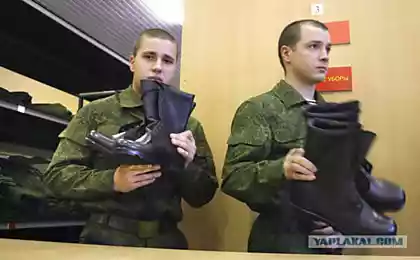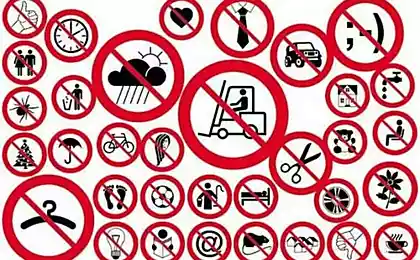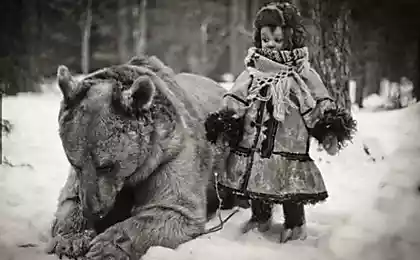1275
Russian breathed through the ground (25 photos)
The most terrible weapons, the warring parties used during the First World War, there were chemical warfare agents. Scientists from different countries have tried to develop ways to protect them.
The first German military gas mask, spring 1915

From the report of Representative of the Russian Red Cross, the 10th Army of the consequences of the German Gas-cylinder attack by the Germans, 9 (22) in September 1916 at the front between Strahovtsami and Lake Naroch.
"Initially, the gas did not have a rapid action, and through telephone reports from the trenches, the attack seemed ineffective. Seven hours, however, the regimental aid station began arriving poisoned; Some brought alive, some already dead bodies, 300 people picked up in the trenches.
About 8 hours have been in the trenches doctors found them virtually unprotected fighters, as those who remained were barely able to fight. In between waves of gas Germans tried to go on the attack, and we were shot; but before reaching the barbed wire, the Germans themselves began to fall from the effects of gases and draining escaped, shot guns followed, the team of which were fortunately uninjured. " From the Order number 873 2 (15) in September 1916 Commander of the armies of the Western Front, General of Infantry AE Evert.
"... Access to positions with no mask on themselves prohibit. On the anti-gas equipment to position itself not shoot, do not put aside, do not leave it to the shelters, dugouts and dugouts on leaving them, especially at night ».
The presence of the Germans personal protection French counterintelligence learned a few days before the first gas balloon attack on French troops at Ypres April 22, 1915 Their Belgian colleagues have found a German defector unremarkable bag of rubberized fabric, which is located inside the wet swab size palm.

The first masks in the troops of the Entente
But any kind of outlandish German equipment, nor indications of the impending deserter "start gas", the French have not caused serious interest. On some bottles, imported by the Germans on the position, they knew, and the contents of these containers was not for them a secret. The only thing to lose sight of the best at the time in the world of counter-intelligence, is the scale of the massacre of people were completely defenseless against the new weapon.
The first German military gas mask was a pad of cotton wool soaked in a solution of sodium hyposulfite. On the third day after the attack at Ypres LPG thousands of French and British women sewed these "masks." But at the front, it was found out that the use of them is not possible. The soldier was forced to push the "mask" a hand to his nose, which prevented him from using chemical weapons during the attack. All the warring armies began a rapid but short period creating a "nasal dressing": the same tampons, but zavyazochki at the back.
By the end of the summer of 1915 developed two alternative approaches to the creation of masks: wet, that is created from fabric impregnated with a special liquid, neutralizing toxic substance (s); and dry, in which the air before it reaches the lungs fighter goes through a box filled with a solid neutralizing or sorbent OB.
The simplest train of thought when creating a wet gas masks was an increase in the size and thickness of the "swab" and creation on its basis of a protective hood covering the head of a fighter. Along this route went to the French and the British, millions of copies of the fetus construction useless masks during 1915 and, in part, 1916.
That's what came first British mask, known as "black muslin respirator." It consisted of cotton wool, sewn into a strip of black muslin. Wool moistened with a solution containing sodium hyposulfite, soda and glycerin (the last - to prevent drying). Achieve a snug fit of the mask did not work, which led to a gas leak.

Respiratory black muslin ("black veil"), summer 1915
It is a square compress of cotton wool, a black sewn muslin covering the mouth and nose. Compress tightly attached to the face cross bandage, tied at the nape. The upper edge of the muslin could serve as protection for the eyes. Such a mask is well protected from small concentrations of chlorine produced gazopuskami, but it does not fit tightly to the face soldier and quickly rushed to shreds in the most inopportune moment.
The impetus for the development of the British gas masks began to testify Canadian soldier who, during the gas attack allegedly saw the Germans to put on his head "bags." So there was the British "helmet Hypo" (giposulfitny), which gave some protection from chlorine, but "transparent" for phosgene.

French soldiers in anti-gas bandages, spring 1915

Helmet "Hypo H", summer 1915
It consisted of a flannel bag impregnated giposulfitnoy mixture, with holes for the eyes, with glasses of celluloid or glass. The bottom edge of the helmet refueled under the jacket, buttoned tightly around the last of the neck. Respiration occurs across the entire surface of the bag, as an exhalation valve it was not.
In the summer of 1915 it became clear that the Germans added phosgene and chlorine cylinders. British chemists were forced to enter into the impregnation of an alkaline solution of sodium phenolate. "Hypo Helmet" was called "helmet P", but as phenol spoiled flannel, had to add another layer of fabric that dramatically reduce heat transfer. Russian chemists convey information about the ability to neutralize the hexamine phosgene, the British used immediately to create a new impregnation. Helmet impregnated composition with hexamine, was called "helmet PH" (January 1916).

Australian soldiers in the "helmet RN" airs uniforms after a chemical attack of the Germans. Prototype "slam PH», «helmet P" had a mouthpiece with exhalation valve to eliminate the neutralization of alkaline impregnation helmet exhaled carbon dioxide.
The soldiers had to learn to breathe in the nose and exhale through the mouthpiece inserted in the mouth.
These helmets were sent to Russia from the United Kingdom and have been tested in the gas chamber of the Chemical Committee GAC. The results were negative. When the content of chlorine in the cell 0, 1% of phosgene and 0, 1%, people kept only a few minutes. To enhance the protective effect of the British helmets have their perepropityvali mixture, which was introduced methenamine. Then the British began to use this compound as a helmet appeared RN.

Mask-stigma Tambyutyu, 1915
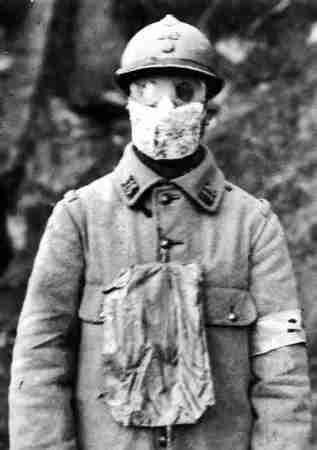
French mask M2 (LTN), February 1916
Two samples of this French masks tested for leakage in gas proof Chemical Laboratory Committee in 1917, did not protect from phosgene at its concentration to 0, 1% and 10% passed this gas for 1 hour at sucking through the mask 15 liters of air per minute .
French chemist whole improved in 1915 found the Germans in April and May, "pad" and "nasal dressings." To protect against the soldiers of benzyl bromide was issued "tampon P" soaked with castor oil or sodium ritsinatom. To protect against further phosgene introduced swab dipped sulfanilovokislym hydroxide and hydrogen cyanide was to hold a tampon impregnated with nickel sulfate ("pad P2»).
To enhance the protective effect of the mask against the phosgene introduced in the impregnation sulfanilovokisly sodium urotropin. Then I had to add the nickel salt to enhance the protection of hydrocyanic acid. It impregnating needed more, so the French built up in layers of gauze masks amount or muslin. A new type of mask - a mask-stigma (Tambyute several types of masks and "wet mask of the new model"). To protect your eyes to the mask-stigma were attached special glasses.

The peak of the evolution of the French became a wet mask covering the face with the eyes of the mask M2 (LTN), received by the army in February 1916. It consisted of 40 layers of gauze impregnated with chemicals sinks: one half was impregnated with a mixture of phosgene and protecting hydrocyanic acid (methenamine, Nickel sulfate and soda), and the other - with a mixture of protecting from benzyl bromide and other lacrimators (castor oil, alcohol, sodium hydroxide). Then increase the number of layers of gauze with sinks was impossible. The head soldier to weld in this mask.
Development of the Russian anti-gas masks in the first months of chemical warfare basically followed the same path as that of the Western allies. The best type of Russian gas mask became wet chemical mask Committee Chief Artillery Directorate (GAU), developed by engineer NT Prokofiev. With the opening of Professor V. Gorbenko (August 1915), the ability to link hexamine phosgene, the Russian appeared impregnation, binding phosgene is almost six times more effective than treatment of the British "hat P».
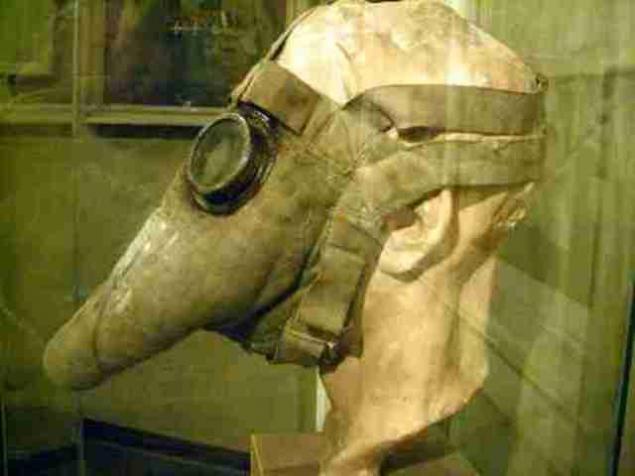
Mask Prokofiev
Prokofiev's mask was made from 30 layers of impregnated gas proof liquid (water, glycerin, potassium, and hypo methenamine) and had a stigma to form a hermetically inserted in a metal-framed glasses. The mask absorbs up to 1 g of phosgene, whereas the "helmet R" - max 0, 059 g of phosgene.
Mask Prokofiev, autumn 1915 In addition to the mask Prokofiev in the Russian army in 1915, there was still wet mask-hood, like the cut in the French and British had no helmets and exhalation valve.
German masks
Excellent chemical school in Germany, of course, and did not allow the thought that German soldiers went on the attack to put on his head stuffy bags soaked face corrosive solutions. When deciding where to place the absorber Germans came to the conclusion that the filter should be a separate part of the mask, which can be screwed to the mask, and, if necessary, remove and replace the other.
Therefore, developers of the German gas masks chemical department of the Prussian Ministry of War together with scientists from the Institute of Physics and electrochemical Emperor Wilhelm (Berlin) constructed in the form of a filter mask is screwed to the cans filled with absorber. He was named patron of a single layer of the sample 28/8. In the autumn of 1915 he replaced as a member of the German military-style protective mask, he entered the army.

German soldiers in rag rubberized gas masks (protective mask military-style) with single cartridge model 28/8 (single cartridge model 1915), autumn 1915
The contents of the cartridge was composed of grains of diatomaceous earth or pumice 2-3 mm in diameter, impregnated with potassium carbonate solution and coated with a thin layer of charcoal. The filtering effect of such holder (as wet masks allies), based on the absorption of chemical agents. The cartridge protects only against chlorine and a small extent of phosgene. However, German soldiers could wear a mask for a few seconds, while dressing wet masks allies minutes left.

German chuck 28/8 sample is a successful design solution of accommodation himpoglotiteley, but contained no new ideas for themselves absorption agents. Resistance to breathing mask and harmful space was small, and the Germans did not deem it necessary to put it to the exhalation valve.
Russian first "dry" gas mask
In Russia, the idea of dry gas mask appeared in May 1915 before the first gas balloon attack the Germans on Russian troops under Bolimovym. The staff of the Imperial Technical School (now the Moscow Technical University. Bauman) has been proposed a chemical absorbent, well-neutralizing chlorine and phosgene. In occasion of the mask should look like, and dry filter mask, the developers of the absorber were no proposals.

Russian soldiers in masks
The idea of dry mask gained practical implementation in the summer of 1915, when the Mining Institute (St. Petersburg) AA Trusevich was established dry mask, known as the "Mining Institute respirator." It is based on the construction of gas masks, previously used in the mine rescue business.
As a chemical absorber Trusevich used soda lime granules. Good gas masks for these respirators had not yet been established. A box absorber was combined with a special mouthpiece and the laces fastened around the head of a soldier clamped nose clip, exhaled air is removed through a valve. Respiratory protected from chlorine, phosgene, hydrocyanic acid, bromine, but to fight it was impossible to soda lime granules blurred by moisture absorbed from the air and closed access to air, dismounting nose clip and exhalation valve proved unreliable.
Russian breathed "through the earth»
Meanwhile, the gas-cylinder attack on the Eastern Front, the Germans showed that poison the Russian people do not just chlorine. Gas bottle attack May 31, 1915 under the Bolimovym on unprepared in anti-gas against Russian troops ended in failure for the Germans.

German gas attack at Bolimovym
Having carried out gazopusk Edge 12 km, the Germans unexpectedly encountered a shot machine gun and artillery fire. A month earlier, half as large-scale gas attack resulted in the death of 5 thousand. French soldiers and a breakthrough on the Western Front for 8 km.
The Russian losses were much smaller (1300 dead), and 11 attempts of the Germans to achieve tactical success turned them heavy losses. Russian rescued ability to improvise. The soldiers fled from chlorine, wrapping his head in a wet cloak, covering his face with his shirt soaked with urine, burying his head in wet hay or breathing through the ground.
Stories about such "miraculous escape" came in letters from the front, and one such letter reached the disgraced professor Zelinsky. In 1911 he was forced out of the University of Moscow and with great difficulty found a place head of the Central Chemical Laboratory of the Ministry of Finance in St. Petersburg, where he worked at the time of the events described.

The professor has been developing ways to clean vodka with the help of non-specific adsorption. As such a sorbent in Russian traditionally use activated charcoal. For Zelinsky scientific explanation of these front-line "miracles" were within his knowledge on gas sorption solids.
August 2, 1915 Zelinsky made a presentation on the absorption properties of activated charcoal at an emergency meeting of the commission studying the experimental clinics, prevention and control methods with gas poisoning in Moscow.
His report was of great interest. The Commission has decided to immediately begin testing anti-gas properties of activated charcoal. By the end of 1915 Professor plagued with failures caused by lack of perfect masks and boxes, best for this method of air filtration. Thanks to the cooperation with Zelinsky industrial engineer from the factory "Triangle" MI Kummantom, developed the original rubber mask to mask, by January 1916 had created an effective mask suitable for use in the armed forces (mask Zelinsky-Kummanta). But as it turned out, Zelinsky created another problem, and command of the Russian army, and himself personally.
Developers mask Mining Institute (which has been repeatedly rejected by the commissions) in the "locomotive" was a powerful relative of the king, Prince AP Oldenburg, who led the all-protection business in Russia.
Contrary to the Chief of Staff of the Supreme Commander of Infantry General MV Alekseev and Minister of War, AA Polivanov, mask Mining Institute began to make millions of pieces and send in the troops.

Instructions for using the mask
In its design the developers have introduced some improvements: they mixed beads soda lime with charcoal (Oldenburg gave them charcoal, intended for Zelinsky) and got rid of his unsuccessful mask, replacing it with a mask Kummanta.
In the box are depicted monogram Prince, and in April 1916, such masks have appeared on the front called "Masks Prince of Oldenburg". Then something happened that should have happened. In July 1916 during the German gas attack at Smorgon became clear mask complete unsuitability of the Mining Institute.
Russian suffered huge losses, by September 1916, this mask seized from the army as unfit. Sunset and the stars of the prince. Neither he nor his office at Headquarters and in the scientific community is no longer taken seriously.
The first German military gas mask, spring 1915

From the report of Representative of the Russian Red Cross, the 10th Army of the consequences of the German Gas-cylinder attack by the Germans, 9 (22) in September 1916 at the front between Strahovtsami and Lake Naroch.
"Initially, the gas did not have a rapid action, and through telephone reports from the trenches, the attack seemed ineffective. Seven hours, however, the regimental aid station began arriving poisoned; Some brought alive, some already dead bodies, 300 people picked up in the trenches.
About 8 hours have been in the trenches doctors found them virtually unprotected fighters, as those who remained were barely able to fight. In between waves of gas Germans tried to go on the attack, and we were shot; but before reaching the barbed wire, the Germans themselves began to fall from the effects of gases and draining escaped, shot guns followed, the team of which were fortunately uninjured. " From the Order number 873 2 (15) in September 1916 Commander of the armies of the Western Front, General of Infantry AE Evert.
"... Access to positions with no mask on themselves prohibit. On the anti-gas equipment to position itself not shoot, do not put aside, do not leave it to the shelters, dugouts and dugouts on leaving them, especially at night ».
The presence of the Germans personal protection French counterintelligence learned a few days before the first gas balloon attack on French troops at Ypres April 22, 1915 Their Belgian colleagues have found a German defector unremarkable bag of rubberized fabric, which is located inside the wet swab size palm.

The first masks in the troops of the Entente
But any kind of outlandish German equipment, nor indications of the impending deserter "start gas", the French have not caused serious interest. On some bottles, imported by the Germans on the position, they knew, and the contents of these containers was not for them a secret. The only thing to lose sight of the best at the time in the world of counter-intelligence, is the scale of the massacre of people were completely defenseless against the new weapon.
The first German military gas mask was a pad of cotton wool soaked in a solution of sodium hyposulfite. On the third day after the attack at Ypres LPG thousands of French and British women sewed these "masks." But at the front, it was found out that the use of them is not possible. The soldier was forced to push the "mask" a hand to his nose, which prevented him from using chemical weapons during the attack. All the warring armies began a rapid but short period creating a "nasal dressing": the same tampons, but zavyazochki at the back.
By the end of the summer of 1915 developed two alternative approaches to the creation of masks: wet, that is created from fabric impregnated with a special liquid, neutralizing toxic substance (s); and dry, in which the air before it reaches the lungs fighter goes through a box filled with a solid neutralizing or sorbent OB.
The simplest train of thought when creating a wet gas masks was an increase in the size and thickness of the "swab" and creation on its basis of a protective hood covering the head of a fighter. Along this route went to the French and the British, millions of copies of the fetus construction useless masks during 1915 and, in part, 1916.
That's what came first British mask, known as "black muslin respirator." It consisted of cotton wool, sewn into a strip of black muslin. Wool moistened with a solution containing sodium hyposulfite, soda and glycerin (the last - to prevent drying). Achieve a snug fit of the mask did not work, which led to a gas leak.

Respiratory black muslin ("black veil"), summer 1915
It is a square compress of cotton wool, a black sewn muslin covering the mouth and nose. Compress tightly attached to the face cross bandage, tied at the nape. The upper edge of the muslin could serve as protection for the eyes. Such a mask is well protected from small concentrations of chlorine produced gazopuskami, but it does not fit tightly to the face soldier and quickly rushed to shreds in the most inopportune moment.
The impetus for the development of the British gas masks began to testify Canadian soldier who, during the gas attack allegedly saw the Germans to put on his head "bags." So there was the British "helmet Hypo" (giposulfitny), which gave some protection from chlorine, but "transparent" for phosgene.

French soldiers in anti-gas bandages, spring 1915

Helmet "Hypo H", summer 1915
It consisted of a flannel bag impregnated giposulfitnoy mixture, with holes for the eyes, with glasses of celluloid or glass. The bottom edge of the helmet refueled under the jacket, buttoned tightly around the last of the neck. Respiration occurs across the entire surface of the bag, as an exhalation valve it was not.
In the summer of 1915 it became clear that the Germans added phosgene and chlorine cylinders. British chemists were forced to enter into the impregnation of an alkaline solution of sodium phenolate. "Hypo Helmet" was called "helmet P", but as phenol spoiled flannel, had to add another layer of fabric that dramatically reduce heat transfer. Russian chemists convey information about the ability to neutralize the hexamine phosgene, the British used immediately to create a new impregnation. Helmet impregnated composition with hexamine, was called "helmet PH" (January 1916).

Australian soldiers in the "helmet RN" airs uniforms after a chemical attack of the Germans. Prototype "slam PH», «helmet P" had a mouthpiece with exhalation valve to eliminate the neutralization of alkaline impregnation helmet exhaled carbon dioxide.
The soldiers had to learn to breathe in the nose and exhale through the mouthpiece inserted in the mouth.
These helmets were sent to Russia from the United Kingdom and have been tested in the gas chamber of the Chemical Committee GAC. The results were negative. When the content of chlorine in the cell 0, 1% of phosgene and 0, 1%, people kept only a few minutes. To enhance the protective effect of the British helmets have their perepropityvali mixture, which was introduced methenamine. Then the British began to use this compound as a helmet appeared RN.

Mask-stigma Tambyutyu, 1915

French mask M2 (LTN), February 1916
Two samples of this French masks tested for leakage in gas proof Chemical Laboratory Committee in 1917, did not protect from phosgene at its concentration to 0, 1% and 10% passed this gas for 1 hour at sucking through the mask 15 liters of air per minute .
French chemist whole improved in 1915 found the Germans in April and May, "pad" and "nasal dressings." To protect against the soldiers of benzyl bromide was issued "tampon P" soaked with castor oil or sodium ritsinatom. To protect against further phosgene introduced swab dipped sulfanilovokislym hydroxide and hydrogen cyanide was to hold a tampon impregnated with nickel sulfate ("pad P2»).
To enhance the protective effect of the mask against the phosgene introduced in the impregnation sulfanilovokisly sodium urotropin. Then I had to add the nickel salt to enhance the protection of hydrocyanic acid. It impregnating needed more, so the French built up in layers of gauze masks amount or muslin. A new type of mask - a mask-stigma (Tambyute several types of masks and "wet mask of the new model"). To protect your eyes to the mask-stigma were attached special glasses.

The peak of the evolution of the French became a wet mask covering the face with the eyes of the mask M2 (LTN), received by the army in February 1916. It consisted of 40 layers of gauze impregnated with chemicals sinks: one half was impregnated with a mixture of phosgene and protecting hydrocyanic acid (methenamine, Nickel sulfate and soda), and the other - with a mixture of protecting from benzyl bromide and other lacrimators (castor oil, alcohol, sodium hydroxide). Then increase the number of layers of gauze with sinks was impossible. The head soldier to weld in this mask.
Development of the Russian anti-gas masks in the first months of chemical warfare basically followed the same path as that of the Western allies. The best type of Russian gas mask became wet chemical mask Committee Chief Artillery Directorate (GAU), developed by engineer NT Prokofiev. With the opening of Professor V. Gorbenko (August 1915), the ability to link hexamine phosgene, the Russian appeared impregnation, binding phosgene is almost six times more effective than treatment of the British "hat P».

Mask Prokofiev
Prokofiev's mask was made from 30 layers of impregnated gas proof liquid (water, glycerin, potassium, and hypo methenamine) and had a stigma to form a hermetically inserted in a metal-framed glasses. The mask absorbs up to 1 g of phosgene, whereas the "helmet R" - max 0, 059 g of phosgene.
Mask Prokofiev, autumn 1915 In addition to the mask Prokofiev in the Russian army in 1915, there was still wet mask-hood, like the cut in the French and British had no helmets and exhalation valve.
German masks
Excellent chemical school in Germany, of course, and did not allow the thought that German soldiers went on the attack to put on his head stuffy bags soaked face corrosive solutions. When deciding where to place the absorber Germans came to the conclusion that the filter should be a separate part of the mask, which can be screwed to the mask, and, if necessary, remove and replace the other.
Therefore, developers of the German gas masks chemical department of the Prussian Ministry of War together with scientists from the Institute of Physics and electrochemical Emperor Wilhelm (Berlin) constructed in the form of a filter mask is screwed to the cans filled with absorber. He was named patron of a single layer of the sample 28/8. In the autumn of 1915 he replaced as a member of the German military-style protective mask, he entered the army.

German soldiers in rag rubberized gas masks (protective mask military-style) with single cartridge model 28/8 (single cartridge model 1915), autumn 1915
The contents of the cartridge was composed of grains of diatomaceous earth or pumice 2-3 mm in diameter, impregnated with potassium carbonate solution and coated with a thin layer of charcoal. The filtering effect of such holder (as wet masks allies), based on the absorption of chemical agents. The cartridge protects only against chlorine and a small extent of phosgene. However, German soldiers could wear a mask for a few seconds, while dressing wet masks allies minutes left.

German chuck 28/8 sample is a successful design solution of accommodation himpoglotiteley, but contained no new ideas for themselves absorption agents. Resistance to breathing mask and harmful space was small, and the Germans did not deem it necessary to put it to the exhalation valve.
Russian first "dry" gas mask
In Russia, the idea of dry gas mask appeared in May 1915 before the first gas balloon attack the Germans on Russian troops under Bolimovym. The staff of the Imperial Technical School (now the Moscow Technical University. Bauman) has been proposed a chemical absorbent, well-neutralizing chlorine and phosgene. In occasion of the mask should look like, and dry filter mask, the developers of the absorber were no proposals.

Russian soldiers in masks
The idea of dry mask gained practical implementation in the summer of 1915, when the Mining Institute (St. Petersburg) AA Trusevich was established dry mask, known as the "Mining Institute respirator." It is based on the construction of gas masks, previously used in the mine rescue business.
As a chemical absorber Trusevich used soda lime granules. Good gas masks for these respirators had not yet been established. A box absorber was combined with a special mouthpiece and the laces fastened around the head of a soldier clamped nose clip, exhaled air is removed through a valve. Respiratory protected from chlorine, phosgene, hydrocyanic acid, bromine, but to fight it was impossible to soda lime granules blurred by moisture absorbed from the air and closed access to air, dismounting nose clip and exhalation valve proved unreliable.
Russian breathed "through the earth»
Meanwhile, the gas-cylinder attack on the Eastern Front, the Germans showed that poison the Russian people do not just chlorine. Gas bottle attack May 31, 1915 under the Bolimovym on unprepared in anti-gas against Russian troops ended in failure for the Germans.

German gas attack at Bolimovym
Having carried out gazopusk Edge 12 km, the Germans unexpectedly encountered a shot machine gun and artillery fire. A month earlier, half as large-scale gas attack resulted in the death of 5 thousand. French soldiers and a breakthrough on the Western Front for 8 km.
The Russian losses were much smaller (1300 dead), and 11 attempts of the Germans to achieve tactical success turned them heavy losses. Russian rescued ability to improvise. The soldiers fled from chlorine, wrapping his head in a wet cloak, covering his face with his shirt soaked with urine, burying his head in wet hay or breathing through the ground.
Stories about such "miraculous escape" came in letters from the front, and one such letter reached the disgraced professor Zelinsky. In 1911 he was forced out of the University of Moscow and with great difficulty found a place head of the Central Chemical Laboratory of the Ministry of Finance in St. Petersburg, where he worked at the time of the events described.

The professor has been developing ways to clean vodka with the help of non-specific adsorption. As such a sorbent in Russian traditionally use activated charcoal. For Zelinsky scientific explanation of these front-line "miracles" were within his knowledge on gas sorption solids.
August 2, 1915 Zelinsky made a presentation on the absorption properties of activated charcoal at an emergency meeting of the commission studying the experimental clinics, prevention and control methods with gas poisoning in Moscow.
His report was of great interest. The Commission has decided to immediately begin testing anti-gas properties of activated charcoal. By the end of 1915 Professor plagued with failures caused by lack of perfect masks and boxes, best for this method of air filtration. Thanks to the cooperation with Zelinsky industrial engineer from the factory "Triangle" MI Kummantom, developed the original rubber mask to mask, by January 1916 had created an effective mask suitable for use in the armed forces (mask Zelinsky-Kummanta). But as it turned out, Zelinsky created another problem, and command of the Russian army, and himself personally.
Developers mask Mining Institute (which has been repeatedly rejected by the commissions) in the "locomotive" was a powerful relative of the king, Prince AP Oldenburg, who led the all-protection business in Russia.
Contrary to the Chief of Staff of the Supreme Commander of Infantry General MV Alekseev and Minister of War, AA Polivanov, mask Mining Institute began to make millions of pieces and send in the troops.

Instructions for using the mask
In its design the developers have introduced some improvements: they mixed beads soda lime with charcoal (Oldenburg gave them charcoal, intended for Zelinsky) and got rid of his unsuccessful mask, replacing it with a mask Kummanta.
In the box are depicted monogram Prince, and in April 1916, such masks have appeared on the front called "Masks Prince of Oldenburg". Then something happened that should have happened. In July 1916 during the German gas attack at Smorgon became clear mask complete unsuitability of the Mining Institute.
Russian suffered huge losses, by September 1916, this mask seized from the army as unfit. Sunset and the stars of the prince. Neither he nor his office at Headquarters and in the scientific community is no longer taken seriously.


